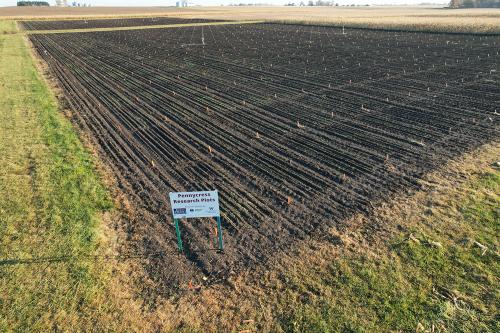|
Research pennycress planted at Western Illinois University farm this month
Macomb, Illinois, USA
October 27, 2022

The pennycress research plots, located at the University Farm.
Just as most of the field crops in west central Illinois are being harvested from the fields, one Western Illinois University professor and his team are planting a unique cover crop at the University farm.
Through an IPREP grant, WIU Agriculture Professor Win Phippen and his staff planted five acres of pennycress seed Oct. 1 on the University farm, north of campus. The plantings will harvested for seeds in the spring.
WIU received $1 million of a $13 million U.S. Department of Energy (DOE) grant to genetically strengthen pennycress plants for use in sustainable energy work. Phippen said through these plantings, researchers are looking for plants that can handle different environmental plant stresses, such as heat or flooding.
The seeds planted on campus represent 435 lines of wild pennycress from all over the world.
"We are trying to identify the useful genes to help the plants handle environmental stresses," said Phippen. "Our purpose is two-fold: conducting observations and looking at agronomic traits, such as plant height, flowering time and seed yield."
Prior to the seeds being placed in the ground by a special planter, purchased as part of the grant, they were divided into small envelopes to keep the types separate. Each plant line was planted individually and then replicated three times across the field.
"All 435 of the wild lines were DNA sequenced, and we are applying new, molecular techniques to identifying which genes are controlling the important traits we are observing in the field," Phippen added.
As the plants germinate, Phippen said they are taking notes of how the plants present themselves, including measurements of the leaf rosettes the plants produce, and all the weather data such as soil moisture and temperature throughout the entire growing season. The goal is to produce consistency, hardiness, and the best plant types available.
The University's other pennycress-related grant, awarded in 2019, through the Integrated Pennycress Research Enabling Farm and Energy Resilience (IPREFER) project, is a five-year, $10 million bio-fuel project to investigate pennycress as a new cash cover crop in the Midwest. The plan was to plant thousands of acres of a variety of genetically edited (GE) seeds this fall in fields in central Illinois.
Because of changing federal regulations on gene-editing plants, the only plantings that can be made this growing season are for demonstration purposes only.
"We had 10,000 acres ready to plant this year," said Phippen. "We are trying to figure out the new regulations. Meanwhile we will make this a demonstration year, where we can host field days and provide valuable information to producers but not harvest the plants commercially. We were ready to grow all of our advanced GE breeding lines in nine locations, but this year we are adjusting to the new rules and will focus on the wild lines until all the regulations get figured out."
For more information on the pennycress projects at WIU, visit iprefercap.org and pennycressresilience.org.
More news from: Western Illinois University
Website: http://www.wiu.edu/ Published: November 8, 2022 |
|
The news item on this page is copyright by the organization where it originated
Fair use notice |